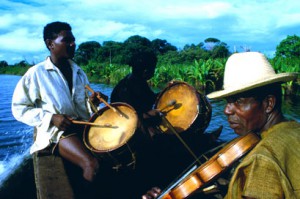Music from Madagascar

Music from Madagascar is divided into three categories traditional, contemporary and popular music.
About: The highly diverse and distinctive music from Madagascar has been shaped by the musical traditions of Southeast Asia, Africa, Arabia, England, France and the United States as successive waves of settlers have made the island their home. Traditional instruments reflect these widespread origins: the mandoliny and kabosy owe their existence to the introduction of the guitar by early Arab or European seafarers, the ubiquitous djembe originated in mainland Africa and the valiha—the bamboo tube zither considered the national instrument of Madagascar—directly evolved from an earlier form of zither carried with the first Austronesian settlers on their outrigger canoes.
Malagasy music can be roughly divided into three categories: traditional, contemporary and popular music. Traditional musical styles vary by region and reflect local ethnographic history. For instance, in the Highlands, the valiha and more subdued vocal styles are emblematic of the Merina, the predominantly Austronesian ethnic group that has inhabited the area since at least the 15th century, whereas among the southern Bara people, who trace their ancestry back to the African mainland, their a cappella vocal traditions bear close resemblance to the polyharmonic singing style common to South Africa. Foreign instruments such as the acoustic guitar and piano have been adapted locally to create uniquely Malagasy forms of music.
Contemporary Malagasy musical styles such as the salegy or tsapika have evolved from traditional styles modernized by the incorporation of electric guitar, bass, drums and synthesizer. Many Western styles of popular music, including rock, gospel, jazz, reggae, hip-hop and folk rock, have also gained in popularity in Madagascar over the later half of the 20th century.
Music in Madagascar has served a variety of sacred and profane functions. In addition to its performance for entertainment or personal creative expression, music has played a key part in spiritual ceremonies, cultural events and historic and contemporary political functions. By the late 19th century, certain instruments and types of music became primarily associated with specific castes or ethnic groups, although these divisions have always been fluid and are continually evolving.1
Similarities to other music styles: The Indian Ocean island of Madagascar separated from mainland Africa some 130-million years ago. Since then, its geography, biology, culture and history have evolved along unique lines. The island’s famed lemurs and other fauna and flora found nowhere else in the world, are explained by its physical isolation. But the unusual cultural mix that underlies Madagascar’s sensational palette of musical styles reflects the brave souls who came to live in this vast, wild, beautiful land. Indonesians, Africans, Arabs, Persians and ultimately Europeans and Asians have all left their marks.
Madagascar’s cultural diversity makes for fascinating music, dance and other art forms but also for complicated politics. Prior to the colonial period, the ethnic Merina had established an expansionist regime based in the island’s central highlands. The Merina succeeded in rebuffing English colonial exploits, but in 1895 the French fought their way to power and created a colony that would last until Malagasy independence in 1960. Government since then has been unstable, marked by riots, coups, rigged elections, one impeachment and, for the people, an ever-worsening economic situation.2
Influences:Madagascar Music combines the traditional folk music of the island and the influences of the cultures that thrive in and around the island nation. The folk flavor of Madagascar music is enhanced by the local music and rhythms. The contemporary styles that form integral parts of music also feature in the art form of the island.
Each region of the island specializes in a particular kind of music. The distinctness of style, lyrics, notes differentiates one form from the other. The uniqueness of Madagascar music lies in its balance of tradition and modernity. This amalgamation is also exhibited in the use of various musical instruments in Madagascar music.
Music of Madagascar is influenced by the races that have settled on this island from time immemorial. The earliest settlers were the Malayo-Polynesians who brought their own style of music to the island. Later when the Arabs and Africans came to Madagascar, the musical variety was further enhanced. Lot of Arabic elements now form an integral part of Madagascar music.
Music of Madagascar is played to the tunes of various musical instruments such as the flute, valiha, harmonica and kabosy.
The popular music of Madagascar constitutes of contemporary rhythms and lyrics. It is influenced by the pop music of the African nations. The most important musical group on the island is Madagascar Tarika. The huge popularity of this band has given Madagascar music a position of importance. 3
DISCOVER MORE
Article: Tarika by Jan Fairley
Published November 21, 2006
Madagascar’s Tarika, led by Hanitra Rasoanaivo, has since the mid-1990s introduced the lively rhythms, vocal harmonies and unique instruments of Madagascar to the larger world.
Son Egal, the group’s award-winning 1997 album, made positive links between Madagascar and Senegal against a complex colonial history, while D celebrated the various regional dance musics and local 45rpm vinyl hits of the 1970s and 80s. 2001’s Soul Makassar, the group’s most acclaimed release, traced the deep links between Madagascar and Indonesia.
In the mid-’80s, Hanitra had served as a translator for a London-based label’s recording of Malagasy traditional music. In 1987, she went to London, where she and her sister Noro appeared on a BBC program on acappella singing. The positive response to it encouraged the siblings to get involved in music back home in Madagascar. From these roots, Tarika emerged.
Hanitra and Noro first performed in a group called Tarika Sammy, which broke up after making one album. In 1993 Hanitra re-formed the group simply as Tarika (meaning, literally, the group), incorporating traditional instruments of Madagascar, including the tubular bamboo zither called the valiha; the marovany double-sided box zither; the jejy voatavo, a distant relative of the dulcimer, with a large gourd resonator; and the small kabosy guitar. To establish themselves, like most world music groups, Tarika embarked on grueling tours in Europe and America, staying on the road for four years and performing at concerts and festivals.
That Tarika’s music has had an impact back home is undeniable, just as it is undeniable that Hanitra believes music can be a force for change there. But she is doing it her own way, acquiring land and putting her efforts into the building of an arts center for people to come, “to make music, drink tea, talk, become friends,” as she put it.4
VIDEOS
Madagascar ” Tarika” Music
Madagascar Music with scenic Images
Source:
1.Music of Madagascar,Wikipedia http://en.wikipedia.org/wiki/Music_of_Madagascar
2.Madagascar Music, Nat Geo Music http://worldmusic.nationalgeographic.com/view/page.basic/
country/content.country/madagascar_22
3. Madagascar Music, Maps of World. http://www.mapsofworld.com/madagascar/society-and-culture/music.html
4. http://www.globalrhythm.net/AfricanLegends/Tarika.cfm









